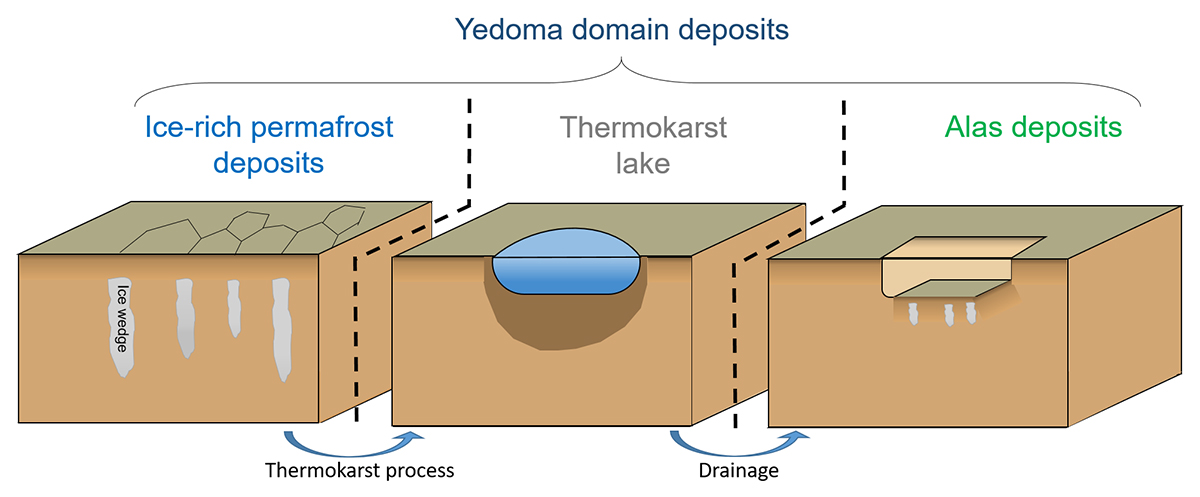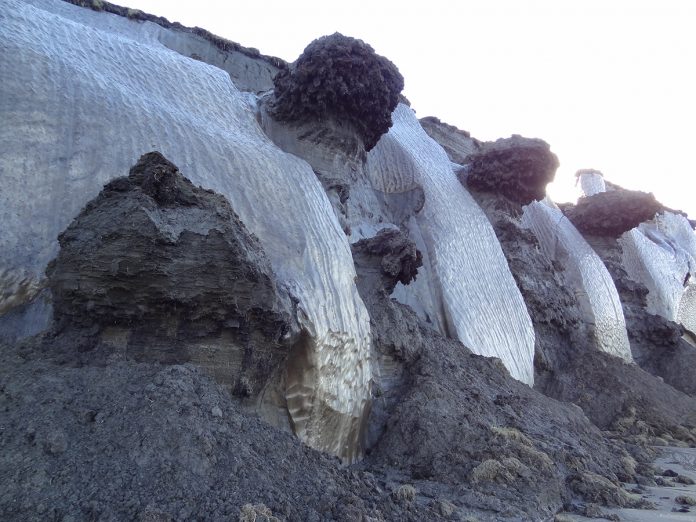Ice-rich permafrost deposits will be transformed in large puddles of water in the coming decades, but before this happens, scientists want to collect information to better understand our past and predict our future, as explained by Arthur Monhonval
In the high northern latitudes of our planet, you may encounter ice-rich permafrost deposits. These deposits were formed thousands of years ago and are composed of massive ice content that made up 50% to 90% of the deposits volume (Figure 1).
Because climate warming is more intense in Arctic regions (two to three times faster than the global average), these witnesses of the past are vulnerable to thaw, exposing substantial amounts of organic carbon and affecting greenhouse gases emissions. The heat dome, recorded this summer 2021 in western Canada at 49.6°C, is a rare event that is expected to occur more frequently in northern latitudes as well as warmer winters. Increasing temperatures put pressure on ice-rich deposits and will lead to ground collapse and lake formation in the future, but with what consequences?
Geological archives
Ice-rich permafrost formation took place around 60,000 years ago and continued for thousands of years. With freezing temperatures, each layer of sediments acts as a book where is inscribed all environmental conditions at the time of their formation (similar to ice cores from Greenland that trap in their frozen air bubbles the climate of the past). During a warmer period that took place in the early Holocene (about 11,000 years ago), some of these ice-rich deposits thawed, creating massive lakes that drained with time.
These deposits in drained thermokarst lake basins are called Alas deposits (Figure 2). Ice-rich permafrost and Alas deposits act as an open-air museum. To some extent, ice-rich permafrost is a relic from the past and Alas deposits a window into the future. Since Alas deposits will expand in the Arctic with the degradation of ice-rich permafrost sediments, the study of Alases formed during the warmer Holocene period is of capital interest to predict the consequences of a warming climate.
Major contribution to global C stocks
Ice-rich permafrost deposits do not only lock up mammoths in their frozen deposits but also organic carbon, slowly accumulating consequently to the dry and cold climate at the time of sediments aggradation. Ice-rich permafrost and Alas deposits gather 327-466 Gigatons (Gt) of organic carbon, i.e., 25-35% of the northern circumpolar region pool (1307 Gt) despite covering only 8% of the coverage. In comparison, the current total carbon pool in the atmosphere is estimated to 829 Gt. Once thawed, this stock of carbon can be vulnerable to microbial mineralisation and emitted as greenhouse gases.
Organo-mineral interactions
In thawed ice-rich permafrost and Alas deposits, mineral elements interact with organic carbon. This may provide physical or physicochemical protection against microbial degradation of organic carbon. Some important mineral elements (iron and manganese) are sensitive to water saturation.

They form oxides under drier conditions or dissolve under wetter conditions. With current warming, the change from ice-rich permafrost deposits to Alas deposits triggers dynamic water saturation conditions that either promote or mitigate the stabilisation of organic carbon. Some reactions involving iron and manganese can even prevent methane production. Organo-mineral interactions are important to predict (i) the mineralisation rate of the organic carbon (i.e., the greenhouse gases production rate) and (ii) the nature of the greenhouses gases (carbon dioxide and/or methane) emitted.
As part of the WeThaw project, Arthur Monhonval collected data from a large-scale campaign involving more than a thousand samples from ice-rich and Alas deposits and highlighted the increase of iron oxides in Alas deposits with direct implications on organic carbon stabilisation. The scientific community has been focusing on the quantification of the stock of organic carbon in the Arctic but only few studies focus on the mineral side of permafrost, which is important given the importance of organo-mineral interactions for long-term organic carbon stabilisation.
Simplified models for complex reality
Organo-mineral interactions are not taken into account in current climate models. Models used to predict trajectories of future climate are simplified because of the multiple parameters at play (organic carbon quantity and quality, temperature, water saturation, microbial diversity and abundance, etc.) However, mineral elements implications in this highly complex ecosystem have been overridden. Our purpose is not to complexify models, but to take into account major mechanisms that may increase or mitigate natural greenhouse gases emissions like organo-mineral interactions.
This research emphasizes the importance of the minerals in direct contact with organic carbon. Organo-mineral interactions are known to be a major factor in mediating present-day and future greenhouse gases emissions. This study contributes to better constraint the protective role of minerals with carbon stabilisation mechanisms to improve current climate models.
Complementary information: Monhonval A, Strauss J, Mauclet E, Hirst C, Bemelmans N, Grosse G, Schirrmeister L, Fuchs M and Opfergelt S (2021) Iron redistribution upon thermokarst processes in the Yedoma domain. Front. Earth Sci. doi: 10.3389/feart.2021.703339

(The WeThaw project is an ERC Starting grant funded under the European Union’s Horizon 2020 research and innovation programme. Grant agreement no. 714617)
Please note: This is a commercial profile
© 2019. This work is licensed under a CC BY 4.0 license.











